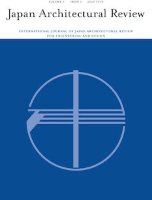
Japan Architectural Review
Scope & Guideline
Fostering collaboration for innovative architectural solutions.
Introduction
Aims and Scopes
- Architectural Design and Construction Processes:
This area encompasses research on innovative design methodologies, construction techniques, and project management practices, often highlighting case studies of significant architectural projects in Japan. - Seismic Design and Structural Analysis:
Given Japan's vulnerability to earthquakes, the journal places a strong emphasis on studies related to seismic performance, including the development of new design models and assessment techniques for enhancing building resilience. - Urban Planning and Community Development:
Research in this scope focuses on urbanization trends, community dynamics, and the socio-spatial implications of architectural interventions, aiming to improve living conditions and accessibility within urban environments. - Sustainability and Environmental Performance:
The journal promotes studies on sustainable architecture, including energy-efficient designs, green building practices, and the use of renewable resources, contributing to the discourse on ecological responsibility in architecture. - Cultural Heritage and Preservation:
A significant area of focus includes the preservation and adaptive reuse of historical buildings, exploring the intersection of tradition and modernity in architectural practice. - Health and Well-being in Built Environments:
Research on how architectural design affects occupant well-being, including studies on indoor environmental quality, public health impacts, and the psychological aspects of space utilization.
Trending and Emerging
- Smart Building Technologies and Automation:
An increasing number of studies are exploring the integration of smart technologies in building design, focusing on automation, data analytics, and the Internet of Things (IoT) to enhance building performance and occupant experience. - Resilience and Disaster Preparedness:
With ongoing concerns about natural disasters, there is a trend towards research on resilience in architecture, including strategies for disaster preparedness and recovery, particularly in the context of climate change. - Social Sustainability and Community Engagement:
Research is increasingly addressing the social aspects of architecture, emphasizing participation in the design process and the role of architecture in fostering community well-being and social cohesion. - Post-Pandemic Design Considerations:
In light of the COVID-19 pandemic, there is a growing focus on how architectural design can adapt to new health standards, including studies on ventilation, spatial layout, and the design of public spaces to promote safety and comfort. - Biophilic Design and Connection to Nature:
Emerging research highlights the importance of biophilic design principles, exploring how incorporating natural elements into architecture can enhance occupant well-being and environmental quality.
Declining or Waning
- Traditional Architectural Techniques:
Research on traditional building methods and materials has decreased, likely due to a growing emphasis on modern design practices and sustainable technologies that prioritize innovation over historical techniques. - International Architectural Comparisons:
While comparative studies between Japanese architecture and international practices were once prevalent, this theme has waned as researchers increasingly focus on localized issues and context-specific solutions. - Purely Theoretical Studies:
There has been a decline in purely theoretical discussions that do not connect to practical applications or case studies, as the journal shifts towards research that offers tangible benefits or solutions to current architectural challenges. - Focus on Aesthetic Trends:
Research centered solely on aesthetic trends in architecture is becoming less frequent, as there is a growing recognition of the need for architecture to address functional, social, and environmental concerns beyond mere visual appeal.
Similar Journals

ARCHITECTURAL RECORD
Illuminating Architectural Insights and PracticesARCHITECTURAL RECORD, published by McGraw Hill Inc, stands as a vital resource in the field of architecture and design, offering insightful perspectives and critical analyses that cater to architects, designers, and academia alike. With an ISSN of 0003-858X, this prestigious journal has been a cornerstone for the architectural community, providing a blend of contemporary practices and theoretical frameworks since its inception. Although it is not currently available through Open Access, its rich content contributes to the ongoing dialogue in both the Visual Arts and Performing Arts, as well as Engineering and Architecture disciplines. The journal's historical impact can be seen through its wide readership and influence in shaping architectural discourse, making it a highly regarded publication for professionals and students in the field. As a beacon of innovative practices, ARCHITECTURAL RECORD continues to inspire and educate, even despite its coverage discontinuation in Scopus since 2018.
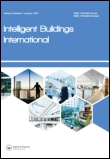
Intelligent Buildings International
Pioneering the Future of Smart Building TechnologiesIntelligent Buildings International, published by Taylor & Francis Ltd, is a premier journal dedicated to advancing knowledge in the interdisciplinary domains of building construction, civil engineering, computer science applications, and planning. Since its inception in 2009, this journal has become a vital resource for researchers, professionals, and students, offering a platform for high-quality scholarly articles that explore innovative strategies and technologies in intelligent building design and efficiencies. With its significant impact factor reflected in its Q2 and Q3 quartile rankings across various related fields, and strong Scopus rankings placing it among the top journals in Geography, Building, and Civil Engineering, Intelligent Buildings International stands out for its commitment to fostering research that enhances the sustainability and functionality of contemporary architectural practices. Readers can access a wealth of articles that illuminate the complexities of smart building technologies and their implications for future construction practices, making it an essential addition to any academic library.
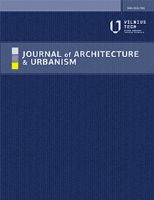
Journal of Architecture and Urbanism
Exploring the Intersection of Design and Urban LifeThe Journal of Architecture and Urbanism, published by VILNIUS GEDIMINAS TECH UNIV, stands as a pivotal resource for scholars and practitioners in the fields of architecture and urban studies. Since its inception in 2012, the journal has committed to advancing research and discourse on the design, planning, and functionality of urban environments, reflecting a dedicated focus on contemporary challenges in architecture and urbanism. With an impressive open access model implemented since 2018, it ensures that innovative research is accessible to a global audience, fostering collaboration and knowledge exchange. The journal boasts a commendable reputation, categorized in the Q2 quartile for Architecture and Q3 in both Geography, Planning and Development and Urban Studies as of 2023, while maintaining respectable Scopus rankings. Addressing key themes from sustainable design to socio-economic impacts on urban spaces, the journal aims to inspire new models and solutions that meet the evolving needs of growing urban populations. This is a must-read for anyone engaged in the intersection of architecture and urban development.

ARCHITECTURAL DESIGN
Advancing Architectural Knowledge and AestheticsARCHITECTURAL DESIGN, a leading journal published by Wiley Periodicals, Inc., serves as a vital platform for discourse in the fields of architecture and visual arts. With an ISSN of 0003-8504 and an E-ISSN of 1554-2769, this esteemed publication offers comprehensive insights into contemporary design practices and emerging architectural theories. Established in the United States and continuously evolving from 2002 to 2024, the journal has secured a prominent position with a Q3 status in Architecture and an impressive Q1 ranking in Visual Arts and Performing Arts as of 2023. Its Scopus rankings further affirm its relevance, with a percentile ranking of 82nd in the Visual Arts category. Although it does not currently offer Open Access options, the journal remains dedicated to disseminating high-caliber research and innovative design strategies that engage a diverse readership of researchers, professionals, and students alike. The contributions published within its pages are instrumental in shaping the discourse around architecture, making ARCHITECTURAL DESIGN an indispensable resource for anyone passionate about the built environment.

ACE-Architecture City and Environment
Unlocking the Potential of Urban Planning and DesignACE-Architecture City and Environment, published by Universitat Politècnica de Catalunya in Spain, serves as an essential repository for innovative research and insights that intersect the fields of architecture, urban studies, and environmental planning. Since its establishment as an Open Access journal in 2006, it has facilitated widespread accessibility to scholarly work, fostering a collaborative and inclusive academic community. The journal has consistently maintained a prominent standing within its field, reflected in its 2023 Quartile rankings—, Q3 in Geography, Planning and Development, and Q2 in Urban Studies. With a publication horizon extending from 2011 to 2024 and an impressive Scopus ranking among peers, it offers a comprehensive platform for researchers to disseminate their findings and engage with contemporary challenges in urban environments. ACE is pivotal for professionals and students alike, striving to shape the future of sustainable architecture and urban planning through rigorous scholarship.
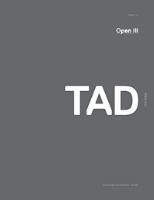
Technology-Architecture + Design
Crafting Tomorrow’s Spaces with Cutting-edge ResearchTechnology-Architecture + Design is a pioneering academic journal published by Taylor & Francis Ltd, dedicated to exploring the intersection of technology within architectural and design practices. With an impactful presence in the field since its inception in 2017, the journal has quickly ascended in academic rankings, achieving a Q2 categorization in Architecture and a notable Q1 ranking in Visual Arts and Performing Arts, underscoring its significance in these dynamic areas of study. The journal aims to provide an open platform for innovative research that addresses contemporary challenges in architecture and urban planning, utilizing technological advancements as a central theme. As a vital resource for scholars, practitioners, and students alike, Technology-Architecture + Design publishes high-quality, peer-reviewed articles that contribute to the discourse surrounding sustainable design, digital fabrication, and smart urbanism, making it an essential read for those passionate about the future of built environments.
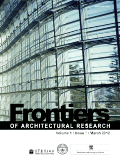
Frontiers of Architectural Research
Transforming Ideas into Architectural PracticeFrontiers of Architectural Research, published by KEAI PUBLISHING LTD, stands at the forefront of interdisciplinary scholarship, addressing contemporary challenges in the fields of architecture, urban studies, building and construction, and archaeology. Since its establishment in 2012, this open-access journal has rapidly gained recognition, achieving prestigious rankings in the 2023 category quartiles, including Q1 placements in both Architecture and Archaeology. With an impressive Scopus rank of #5 out of 354 in Archaeology and #10 out of 189 in Engineering - Architecture, it demonstrates its significant influence and contribution to advancing architectural research. Frontiers of Architectural Research embraces a broad scope that fosters innovative discourse and practical solutions, catering to a diverse audience of researchers, professionals, and students keen on exploring the intersection of culture, environment, and technology. By ensuring immediate access to research findings, the journal not only enhances the visibility of scholarly work but also encourages collaborative dialogues that shape the future of architectural practice.

Contexto-Revista de la Facultad de Arquitectura Universidad Autonoma de Nuevo Leon
Cultivating Critical Analyses in Urban DevelopmentContexto-Revista de la Facultad de Arquitectura Universidad Autonoma de Nuevo Leon is a prominent open-access journal published by the Universidad Autonoma de Nuevo Leon, Faculty of Architecture, dedicated to the fields of architecture, urban studies, and visual arts. Since its establishment, the journal has steadily contributed to the discourse in these interconnected domains, particularly given its commitment to open access since 2011, allowing for wider dissemination of knowledge and research. With its ISSN 2007-1639, Contexto has evolved to encompass a range of topics pertinent to contemporary architectural practices and urban development trends, reflecting its vision to foster innovative dialogues and critical analyses among researchers, practitioners, and students. With a current Scopus ranking showcasing its influence—specifically a Q4 classification in Architecture and Urban Studies, and a Q2 in Visual Arts and Performing Arts—this journal serves as a vital resource for academia and industry alike. Authors and readers are encouraged to engage with its dynamic content and contribute to its ongoing mission of enriching the architectural and urban narratives within Mexico and beyond.

Frontiers in Built Environment
Advancing sustainable solutions for urban futures.Frontiers in Built Environment, published by FRONTIERS MEDIA SA, is a highly regarded open-access journal that has established itself as a significant platform for cutting-edge research in the fields of building and construction, geography, planning and development, and urban studies. Since its inception in 2015, this journal has embraced a commitment to disseminating high-quality, peer-reviewed research, allowing researchers, professionals, and students to access pivotal findings and insights without financial barriers. With an impressive 2023 impact factor, it ranks in the Q1 tier for Urban Studies and is positioned within the Q2 tier for both Building and Construction and Geography, Planning and Development, demonstrating its influence and relevance in evolving urban and environmental challenges. Its rigorous indexing, exemplified by a strong Scopus ranking, reflects its contribution to the advancement of knowledge in these critical areas. With a clear dedication to fostering innovation and collaboration within the built environment sector, Frontiers in Built Environment is essential reading for those engaged in shaping sustainable urban futures.

Russian Journal of Building Construction and Architecture
Unlocking Insights for a Resilient Built EnvironmentRussian Journal of Building Construction and Architecture (ISSN: 2542-0526; E-ISSN: 2542-0526), published by the esteemed Voronezh State Technical University, serves as a vital platform for disseminating innovative research and practical applications in the fields of building construction and architecture. This journal, situated in Voronezh, Russia, aims to explore both the theoretical and empirical aspects of contemporary architecture and construction practices, fostering a robust dialogue among researchers, professionals, and academics. With an emphasis on open access to knowledge, the journal significantly contributes to global discourse by ensuring that findings are accessible to a wide audience. Underlining the importance of sustainable development and cutting-edge technologies in construction, the journal strives to publish high-quality research that addresses the challenges faced in today’s building environment, making it an invaluable resource for those committed to advancing the industry.